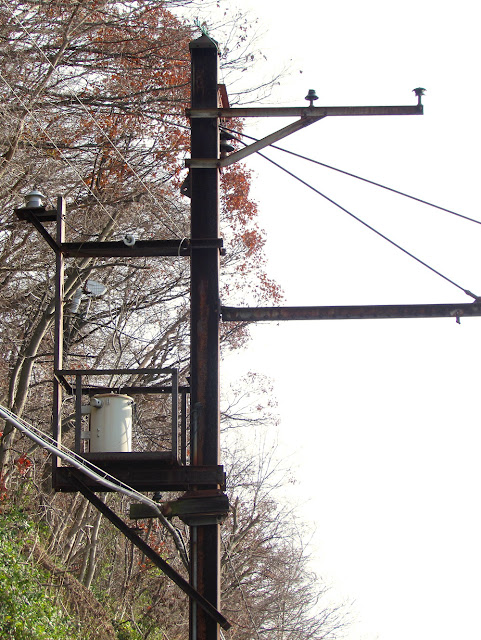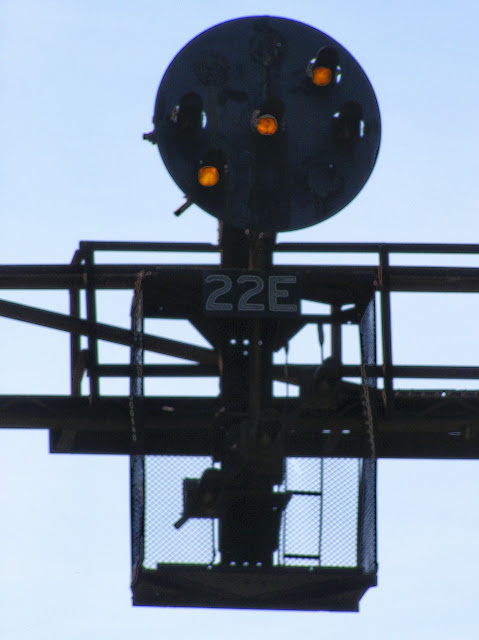Today we are going to examine approach lit signals, what they are, their history, how they are classified and finally, who is using them. What they are is in the name. The signals only illuminate when the signaling system believes a train is approaching (or otherwise nearby). This is one of those things that people are likely more aware of than they think. The assumption is that a signal should always be lit as that's the way it works in traffic control. However anyone who lives around approach lit signals are quick to tell me that "those light up when a train is coming" since its hard not to eventually notice the pattern.
Approach lighting actually goes way back to the days of battery operated block signals where workers would have to physically haul out more electrons when any given signal's supply ran low. With LED technology decades away, the first solution was semaphore signals that didn't need electric illumination. Since this didn't work well at night, a second solution was to link an electric lamp to the track circuit relay in such a way that a shunt of the track circuit would close the lamp's circuit and illuminate the signals. Since railroad relay logic both then and now allow one input to control 8 or sometimes more other circuits in a single relay, this was a pretty straightforward arrangement.
 |
| Typical railroad battery case |
Although pure battery based power supplies were eliminated over time, approach lighting remains fairly popular to this day. The first reason is that 440v pole line railroad power was both limited in transmission capacity and still not reliable and any fault could drop an entire line segment onto battery backup for hours or even days. The second reason is what most people would assume to be the first, saving on bulb replacement. while certainly a concern, low watt railroad lamps are pretty long lived as is and we can also observe the behavior of 20th century railroads to determine their motivations. Where railroad power was plentiful and reliable, think the PRR's electrified region with 6.9kv 100hz supplies or something like the N&W H-Line that was fed by a kv range 3 phase line supply, signals were lit full time where elsewhere on the same railroads approach lighting was employed.
There are several general classes of approach lighting that I have arranged into bins of my own design.
- Type 1: Type 1 approach lighting is where a signal illuminates only when it's approach block is shunted. It's the simplest in concept and can be readily observed as when the tail end of a train passes the signal, the signal will deluminate.
- Type 1a: This is an even more extreme version of Type 1 where on a multi
track line a shuntedn will only illuminate the signal that governs it.
- Type 2: Here a signal location in CTC or other bi-directional territory
will illuminate in both directions if either approach block is shunted.
Therefore the signal will remain lit for a further period of time once
the end of the train passes.
- Type 2a: Same multi-track effect as Type 1a, except also in both directions.
- Type 3: Here a signal will illuminate if a shunt exists within the
entire line segment either in advance or in rear of the signal. This is
most applicable in single track CTC or Bi-directional ABS territory and
may or may not actually exist in real life.
- Type 4: Another possibly theoretical example would be an approach lighting scheme at interlockings where signals will illuminate if a route is displayed, regardless of (or in addition to) track circuit status.
At this point I have only ever fully confined the use of Types 1 and 2 approach lighting, however a number of anomalies have hinted at Type 3 or 4. There is of course another major exception to these rules in the form of non-circuited track like sidings, secondary tracks or yards. Signals governing these tracks must remain lit at all times as there is way to detect an approaching train.
 |
| Amtrak Hudson Line CP-156 showing the 24/7 lit siding dwarf and approach lit main track signal. |
Use of approach lighting has varied widely in the time since power limitations became less of a driving force. Even where power is still provided by a pole line or solar panel, LED lighting would allow for 24/7 display of signals on a fairly small power budget. There is a small safety boost in that wayside signals can serve as an additional method to alert workers of an approaching train, however it is too unreliable to ever be codified into a rulebook. Even aggressive users of approach lighting will often make exceptions, especially in built up terminal areas once again pointing to power availability or signal access as a major factor.
At this point Union Pacific is the most aggressive user of approach lighting, employing Type 2a in all of its most recent signal projects. NS on the other hand is likely the Class 1 most in favor of 24/7 signals, often replacing Conrail era approach lit signals with full time. CSX uses a mix, but tends towards full time in contrast to the B&O, which was very much in favor of Type 1. Unfortunately I don't have enough experience with BNSF, CN or CP to comment on their specific tends however at a regional level the old Guilford favors approach lighting while the Reading and Northern splits the difference with full time at interlockings and approach lit at intermediates.
 |
| UP acting like its charged by the photon. |
On the passenger side of things approach lighting is much less common as commuter railroads operate in dense metros that have has reliable electric power for well over a century. New Jersey Transit was probably the biggest user of approach lighting and with 1 mile blocks on many of its trunk lines it is possible to observe the next signal light up like a Christmas tree after passing the one before it. However new Rule 562 territory as well as the RiverLINE light rail have both tended towards full time. Amtrak used to use Approach lighting on its diesel lines like Michigan, Springfield and Atlantic, but has trended to towards full time, although the new CP-138 on the Hudson Line is approach lit. The other major commuter carriers such as Metro North, LIRR, SEPTA, MBTA, Metra and Caltrain all use primarily full time signals.
 |
| NJT signals at SAUK interlocking are Approach Lit, while those protecting the drawbridge at the joint Conrail interlocking CP-JERSEY are not. |
From an fan perspective, approach lighting definitely has its pros and cons. Dark signals are certainly less interesting than lit and deprives one from being able to observe any routes lines up in advance. However the ability of approach lighting to act as a train proximity warning is highly useful, although could likely be replicated by a radio scanner. It also causes use of a so called "two minute drill" to get photos of displayed signal indications in the time between when a train enters a block and then passes the signal (or passes the signal and then exits the following block). Salience of the two minute drill actually confirmed the operation of mid-block Signal Indication Points on Conrail's cab signal territory as the approach lighting would only trigger once the approaching train passed the mid-block SIP instead of the previous wayside signal location, thus turning a 2 minute drill onto a 1 minute drill.
That's probably more than you needed to know about approach lighting. Unlike a lot of signaling trends this one is pretty neutral with neither definite trends in its use nor any major effect on the ecosystem either positive or negative.

























































